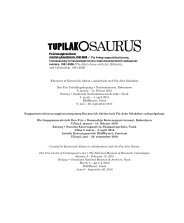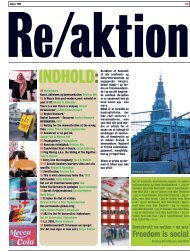tupilakosaurus - Print matters!
tupilakosaurus - Print matters!
tupilakosaurus - Print matters!
Create successful ePaper yourself
Turn your PDF publications into a flip-book with our unique Google optimized e-Paper software.
taaneqartartoq Perlustrationer<br />
1-10. 1994<br />
kræftip navianartorsiortitsineranik eqqorpaatigut.<br />
Pulaartoq pinngitsaalisatut kræftimik eqqorneqarsimasumut<br />
qiviartariaqarpoq, eqqissinissaminulli<br />
ikiorserneqarluni qissiminnermit oqaluttuartumillusooq<br />
arnaassutsip ilivitsuusup, tamarmiusup,<br />
uteqqinnissaanik takorluuinermut. Malugineqarsinnaavoq<br />
ikeq ikillu maminnissaa nakorsat<br />
paaseriigaasa illuatungerluinnaaniittoq, soorlu<br />
immaqa kulturit marluk akornanniilersimasup<br />
misigisamigut kingunerlutsitsilersumut assersuunneqarsinnaasoq.<br />
Kisianni Arkep isiginnitsini<br />
taama ajornanngitsigisumik misigitikkusunngilai.<br />
Assilissat arfineq pingasut taakku akornanniippoq<br />
saqqummersitami assilissat paasiuminaannersaat,<br />
inuup assilineqarusunngitsutut ittup assinga, sequnnginganermigulli<br />
takutitsisoq kinaassutsiminik<br />
illuatungiliisutut, nittarsaatin-ngitsoq, eqqarsarpasissoq<br />
nappaateqarneranillu malunnaateqanngitsoq.<br />
Ataqqinarpaluttumik eqqissisimalluni,<br />
takorluukkamini taartuniilluni, kiinaa assilissatut<br />
saqqummeriartorpoq, pingaa-ruteqarpaluttutut,<br />
kalaallit kiinarpaliaattuulli pingaaruteqarpalutsigaluni,<br />
Inuillu nagguippiaanniippalulluni,<br />
qaqugumulluunniit atasussamik eqqortuusumik<br />
uppernarsaatitut naalakkersuisut mitallikujussinnaasunik<br />
silatusaarniarnerisa qeqqanni ataqatigiissitsiniartutut.<br />
Tamanna saqqummersitani immaqa qajassuaassinnaasumik<br />
nassuiaaneq eqqumiitsuliortup<br />
nammineerluni nassuiaaserpaa qulequttat marluk<br />
ataqatigiissinnerisigut. Qulequttamik Nature<br />
Morte (oqaatsip nagguia malillugu isumaqartumik<br />
“pinngortitaq toqungasoq”) atuinermigut<br />
nassuiaannanngilaa tassaaginnangitsut aalasortaqanngitsumik<br />
assilisat, ersersilluguttaarli<br />
toqoriaatsit marluk periaannaasut: Piviusoq<br />
tunniutarlu, tassalu suli inuutilluni aanaveersagaaneq,<br />
eksimuujusuusaarneq kalaaliulluniluunniit<br />
allamiunngortitaaneq. Illuatungaani Perlustrationer-ini<br />
Arkep nunasiaataaqqaarnermiit<br />
pissutsit ingerlateqqippai, oqaatigilluaannarlugu<br />
Hans Egedep ilisimalikkaminik atuakkiaa 1741mi<br />
saqqummersoq qulequtaqarluni Det gamle<br />
Grønlands nye Perlustration eller Naturel-Historie.<br />
Takornartat oqaasiinik ordbogip, Meyerip<br />
qanga saqqummersitaata, takutippaa oqaatsit<br />
atorneqartut toqqaannarlugu nutserneqassasut<br />
“Misissuineq, katersuineq”. Taamaattoq<br />
oqaatsinik paasinnittaaseq paasiniarluariaraanni<br />
oqaaseq “perlustrere” nutserneqarsinnaalerportaaq<br />
“oqallisiginninneq”. Sulilu tarparnerusarpoq<br />
oqaatsit nagguiinik nalusut “paasisitsiniaallutik”<br />
oqaatsip nutserneqarnissaatut siunnersuutigigaangassuk<br />
“qinngorneqalersippaa, nersorpaa”.<br />
Oqaatsit nagguiinik isumaannillu qanorlu<br />
aamma isumaqartinneqarsinnaanerinik, uani<br />
taasannik, Arkep atuiniarsimasinnaanera<br />
ilisimasinnaanngilarput. Kisianni arlariinnik<br />
qulequtsiilluni suliaqarsimanera kissaatigisamut<br />
tulluuppoq, isornartorsiuisinnaanerata eqqumiitsuliortutullu<br />
suliaasa taanna qularutissartaarutitikkunarpaat.<br />
Suliaasa kingulliit tamanna suli<br />
sakkortunerusumik uppernarsarpaat.<br />
Finn Thrane<br />
Pia Arke. Nature Morte alias Perlustrations 1-10. 1994<br />
Anyone who in 1994 was confronted<br />
for the first time and without any<br />
kind of preparation with Pia Arke’s<br />
series of black-and-white photos<br />
received no help either from the<br />
photographer or from the titles that<br />
the artist was juggling with: Nature<br />
Morte or Perlustrations. But with<br />
them the series expands and plays<br />
teasingly with their meanings. Like a<br />
decisively cut film it jumps ruthlessly<br />
between the private and the official,<br />
between light and dark, between present<br />
and past and between fiction and<br />
documentation. Through these apparently<br />
incompatible components and<br />
narrative modes the work places itself<br />
promisingly, for as an artist Arke<br />
never became easy to deal with. Like<br />
the rest of her oeuvre the series is a<br />
fearless settlement of accounts with<br />
the picture of Greenland she brought<br />
with her from her childhood in the big<br />
Arctic country and not least with the<br />
interpretations of that country and its<br />
population that she encountered as an<br />
adult when looking for information on<br />
the near or distant Greenlandic past<br />
in public libraries or scientific reports.<br />
In a close reading of the series it becomes<br />
possible to distinguish between<br />
narrative time and narrated time.<br />
Thus we are placed by the author in<br />
narrative time when Arke opens the<br />
series with the right hand’s gesture<br />
of welcome and in the concluding<br />
picture rounds it off with the left<br />
hand’s signal that the framework has<br />
been closed again. In the intervening<br />
eight pictures we explore the narrated<br />
time’s various niches; first through<br />
a meeting with the toy dog that suggests<br />
the unconscious innocence of<br />
childhood, later through the meeting<br />
with old texts in leather bindings that<br />
among other things bear the name<br />
of the 18th century preacher Hans<br />
Egede and later again through the<br />
stylised illustration and the attached<br />
instruments that anticipate the<br />
metrological rules of science and the<br />
ethnologist’s reductive methods of<br />
investigation. But while these motifs<br />
are present as museal objects to be<br />
studied (the dog and the books are<br />
placed between book ends, ready to be<br />
labelled and viewed from a distance),<br />
the remaining pictures take us on a<br />
visit in a women’s world that allegedly<br />
borders on the narrative time of<br />
the work and from this position delivers<br />
the series’ passionate existential<br />
counterpoint.<br />
In a clinical white light the threat of<br />
cancer meets us head on. The viewer<br />
is forced to exchange glances with<br />
the cancer sufferer but is helped to<br />
find repose by the discreet glimpse<br />
of the prosthesis that can bring back<br />
the illusion of intact femininity.<br />
One senses that the wound and its<br />
healing are founded on perspectives<br />
that go beyond the medical diagnosis,<br />
perhaps as a metaphor for the trauma<br />
that afflicts those who stand between<br />
two cultures. But Arke does not let<br />
her viewer off so lightly. Among the<br />
eight pictures of the series there remains<br />
its most enigmatic image – the<br />
portrait that refuses to be a portrait,<br />
but with its closed eyes becomes<br />
the author’s alter ego, introverted,<br />
thoughtful and without visible signs<br />
of illness. Serenely calm, resting in<br />
the darkness of the dream, the face<br />
grows into a picture, loaded with<br />
meaning like a Greenlandic mask and<br />
Inuit archetype, a timeless witness to<br />
the truth and a mediator between the<br />
other soberly ironic statements.<br />
This possibly rather heavy-handed<br />
interpretation of the series feeds on<br />
commentaries from the artist herself<br />
via the dialogue between the two<br />
titles she has used. By Nature Morte<br />
(which literally means “dead nature”)<br />
she comments not only on the still<br />
lifes used by the series, but also links<br />
up to the two forms of death lying in<br />
wait: both death as such and death<br />
in a metaphorical sense, namely<br />
becoming embalmed while still alive,<br />
becoming an Eskimoic prosthesis<br />
or alienated Greenlander. With the<br />
alternative title Perlustrations Arke<br />
establishes a link with the early<br />
colonial days, with Hans Egede’s<br />
account of his explorations published<br />
in 1741 under the title Det gamle<br />
Grønlands nye Perlustration eller<br />
Naturel-Historie [The Old Greenland’s<br />
New Perlustration or Natural<br />
History]. Meyer’s old dictionary of<br />
loan words gives the strict translation<br />
of perlustration: “Review, inspection”.<br />
The English verb form, “perlustrate”,<br />
means to travel though an area,<br />
while if we drop the prefix, the Latin<br />
“lustrate” has the figurative meaning<br />
of “to illuminate”.<br />
We cannot know whether Arke played<br />
with etymology and connotations<br />
along these lines. But it can scarcely<br />
be doubted that the two titles she<br />
worked with were intended to create a<br />
fusion of the critical and artistic fields<br />
in which she worked. Her later production<br />
provides strong proof of this.<br />
Finn Thrane<br />
57




